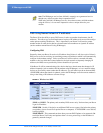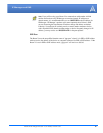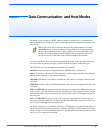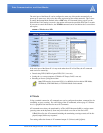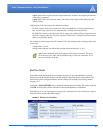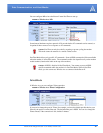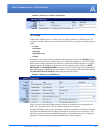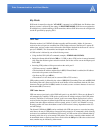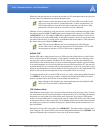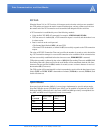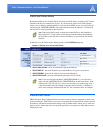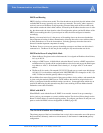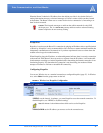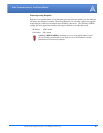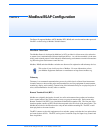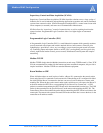
Raven X EV-DO for Verizon - User Guide, version 2.34 23
Data Communication and Host Modes
When idle, after the time-out has occurred, the modem is in AT command mode on the serial port,
and any valid AT command may be entered during this time.
Note: It is best to ensure the idle time-outs for TCP and UDP are never 0 if you're
going to be using auto-answer, or either PAD mode. In those circumstances, you
will want the modem to close the socket if the connection goes idle for too long,
particularly if the other side doesn’t normally close the connection.
When the session is initiated by serial data, the new session will be established using the destina-
tion address specified in S53. The S53 setting can be changed if the connect to last UDP setting
(*UDPLAST=1) is set. The address in S53 will be updated to reflect the address of the last ses
-
sion initiated by an incoming UDP packet. So that when new data is received over the host serial
port while in the idle state, a session will be re-established with the last address. (This behavior is
the same as the previous Hybrid2 (MD6) mode).
Note: TCP auto answer (S0) may also be set simultaneously with UDP auto
answer. Then, when in the idle state, the modem will accept either a TCP or UDP
incoming packet, and enter a TCP or UDP session as appropriate.
Reliable UDP
Reliable UDP adds a simple protocol on top of UDP to provide reliable delivery of data. When
data is received from the host serial port, a 2 byte header is added to the data, containing a mes
-
sage type and a sequence number. The Raven X will continue to send this data (buffering any
received data in the meantime) until it receives an acknowledgement with this sequence number.
If an acknowledgement is not received within the time-out period (specified in S7), the data will
be retransmitted. This will continue until an acknowledgement is received or the modem is reset.
Likewise any UDP packets received by the Raven X are expected to have this simple header. The
Raven X will issue an acknowledgement for any valid packets which are received.
To configure the Raven X for a normal UDP session, you need to set the Startup Mode Default to
73 (ATMD73). If you are using two modems, configure the Destination IP and Port in each to
point to each other. Serial data will then be sent reliably between the two.
Note: Although it adds reliability, the simple implementation of the Reliable UDP
mode in the does not check for duplicate packets.
UDP Multicast Mode
UDP Multicast mode results in any data received from the host serial port being sent to all the cli-
ents in the address list. The remote port number is taken from S53. To avoid flooding the network,
the packets are sent to each client with a 20ms pause in between. The receipt of UDP packets
works as in normal UDP mode (i.e. bound by the value S53 and/or AIP). Since it may take a while
to transmit the data to all hosts (especially if all 20 Modbus entries are used and name resolutions
are required), new data received from the host port is buffered until current transmissions to all
hosts are finished.
Enter the list of target IPs in the address list (ADDR LIST). The index numbers in the list aren't
used. Configure for a normal UDP session. Set the Startup Mode Default to 83 (ATMD83). Con
-
figure the Destination port to match the device port of the remote modems.



